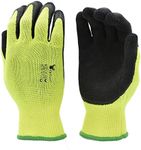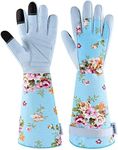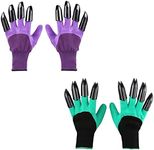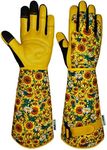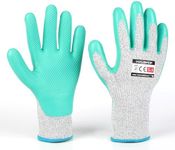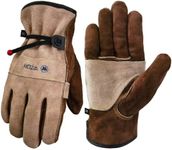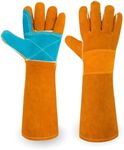Buying Guide for the Best Gardening Gloves
Choosing the right gardening gloves is essential for ensuring comfort, protection, and efficiency while working in your garden. The right pair of gloves can protect your hands from thorns, blisters, and dirt, while also providing the dexterity needed for delicate tasks. When selecting gardening gloves, consider the type of gardening you will be doing, the climate, and your personal comfort preferences. Here are some key specifications to consider when choosing gardening gloves.MaterialThe material of gardening gloves is crucial as it determines the level of protection, comfort, and durability. Common materials include leather, cotton, and synthetic fabrics. Leather gloves are durable and provide excellent protection against thorns and rough surfaces, making them ideal for heavy-duty tasks. Cotton gloves are lightweight and breathable, suitable for light gardening tasks and hot weather. Synthetic gloves, often made from materials like nitrile or neoprene, offer a balance of protection and flexibility, and are often waterproof. Choose the material based on the type of gardening you do and the level of protection you need.
Fit and SizeThe fit and size of gardening gloves are important for comfort and functionality. Gloves that are too tight can restrict movement and cause discomfort, while gloves that are too loose can slip off or make it difficult to handle tools. Most gloves come in small, medium, and large sizes, but some brands offer more specific sizing. To find the right fit, measure the circumference of your hand around the knuckles and compare it to the sizing chart provided by the manufacturer. A well-fitting glove should be snug but not tight, allowing for full range of motion.
GripGrip is an important feature in gardening gloves, as it affects your ability to hold tools and handle plants. Gloves with textured palms or fingers provide better grip, which is especially useful when working with wet or slippery materials. Some gloves have rubberized or silicone coatings on the palms and fingers to enhance grip. Consider the type of tasks you will be performing and choose gloves with an appropriate level of grip to ensure safety and efficiency.
DurabilityDurability is a key factor in choosing gardening gloves, as it determines how long the gloves will last under regular use. Durable gloves are made from high-quality materials and have reinforced stitching in high-wear areas. Leather and synthetic gloves tend to be more durable than cotton gloves. If you do a lot of heavy-duty gardening, such as digging or handling rough materials, opt for gloves that are specifically designed for durability. For lighter tasks, a less durable but more comfortable glove may be sufficient.
Water ResistanceWater resistance is an important feature for gardening gloves, especially if you work in wet conditions or handle water frequently. Water-resistant gloves are made from materials that repel water, such as rubber or certain synthetic fabrics. Some gloves are fully waterproof, while others have water-resistant coatings. If you often work in wet soil or rainy conditions, choose gloves with good water resistance to keep your hands dry and comfortable. For dry conditions, water resistance may be less of a priority.
BreathabilityBreathability is important for keeping your hands comfortable, especially during long gardening sessions or in hot weather. Breathable gloves are made from materials that allow air to circulate, reducing sweat and heat buildup. Cotton gloves are typically the most breathable, while some synthetic gloves have mesh panels or ventilation features. If you tend to get hot and sweaty hands, look for gloves with good breathability to ensure comfort while you work.
Flexibility and DexterityFlexibility and dexterity are important for tasks that require precision, such as planting seeds or handling delicate plants. Flexible gloves allow for a full range of motion and make it easier to perform detailed work. Gloves made from thinner materials or those with added stretch tend to offer better dexterity. If you need to perform fine motor tasks, choose gloves that prioritize flexibility and dexterity. For more heavy-duty tasks, you may need to balance flexibility with protection.

